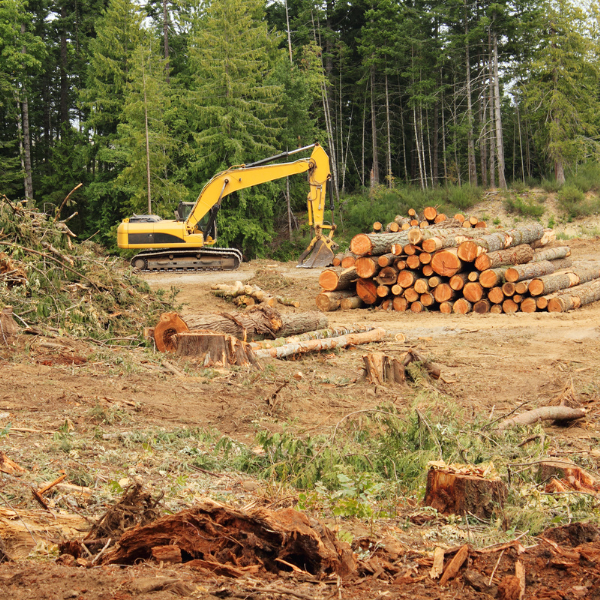End Deforestation
Deforestation refers to the permanent removal of trees and vegetation cover from forests. It occurs due to various factors, including agricultural expansion, logging, mining, infrastructure development, and urbanization. The consequences of deforestation are far-reaching and include soil erosion, habitat destruction, increased greenhouse gas emissions, and disrupted water cycles.
Deforestation is a critical environmental issue that demands urgent attention. The destruction and clearing of forests not only contribute to climate change but also leads to the loss of biodiversity and the displacement of indigenous communities.

Causes of Deforestation
Agricultural Expansion
One of the primary drivers of deforestation is the conversion of forest lands into agricultural areas. Large-scale commercial farming, particularly for commodities like soy, palm oil, and cattle ranching, contributes significantly to deforestation in countries such as Brazil and Indonesia.
Logging
Unsustainable logging practices, both legal and illegal, result in the loss of millions of hectares of forests each year. Logging for timber, pulp, and paper industries contributes to deforestation in regions like the Amazon rainforest and the Congo Basin.
Mining
Extractive industries such as mining for minerals, oil, and gas often involve clearing large areas of forests. The extraction of resources can lead to habitat degradation, soil contamination, and water pollution, endangering both wildlife and local communities.
Infrastructure Development
The construction of roads, dams, and other infrastructure projects often necessitates clearing vast stretches of forests. This not only directly destroys habitats but also opens up previously inaccessible areas to further deforestation.
Urbanization
As populations grow, urban expansion encroaches on forested areas. Rapid urbanization results in the loss of biodiversity-rich habitats and disrupts ecosystems that provide essential services such as carbon sequestration and water regulation.
Consequences of Deforestation
Climate Change
Forests act as carbon sinks, absorbing substantial amounts of CO2 from the atmosphere. Deforestation contributes to increased greenhouse gas emissions, exacerbating climate change and global warming.
Biodiversity Loss
Forests are home to an estimated 80% of terrestrial biodiversity. When forests are destroyed, countless species lose their habitats, leading to a loss of biodiversity and potential extinctions.
Soil Erosion
The removal of trees destabilizes soil structure and reduces its ability to retain moisture. This leads to increased erosion, loss of fertile topsoil, and decreased agricultural productivity in surrounding areas.
Water Cycle Disruption
Forests play a crucial role in regulating water cycles by absorbing rainfall, replenishing groundwater reserves, and maintaining river flows. Deforestation disrupts these processes, leading to altered rainfall patterns, reduced water availability, and increased vulnerability to droughts and floods.
Current Efforts to Combat Deforestation
International Agreements
Several international agreements aim to address deforestation, such as the United Nations Framework Convention on Climate Change (UNFCCC) and the Paris Agreement. These agreements emphasize the need for sustainable land use practices and encourage countries to reduce deforestation rates.
Certification Schemes
Organizations like the Forest Stewardship Council (FSC) certify sustainably managed forests and promote responsible sourcing of timber and forest products. Similarly, the Roundtable on Sustainable Palm Oil (RSPO) certifies palm oil produced through environmentally and socially responsible practices.
Government Policies
Governments play a vital role in combating deforestation by implementing policies that protect forests and promote sustainable land use practices. Some governments have established protected areas, introduced reforestation programs, and enforced regulations against illegal logging.
Corporate Responsibility
Many companies have recognized their role in driving deforestation through their supply chains. As a result, they have committed to zero-deforestation policies, traceability systems, and partnerships with local communities to ensure sustainable sourcing practices.
Practical Steps Towards Ending Deforestation
Promoting Sustainable Agriculture
Encouraging sustainable farming practices such as agroforestry and organic farming can help reduce the need for forest clearance for agriculture. Supporting small-scale farmers and empowering them with knowledge and resources can lead to more sustainable land use.
Strengthening Law Enforcement
Governments need to strengthen law enforcement efforts to combat illegal logging and land encroachments. This includes increasing penalties for illegal activities, investing in monitoring technologies, and supporting local communities in safeguarding their forests.
Investing in Forest Restoration
Reforestation and afforestation initiatives must be scaled up globally. Investing in restoring degraded forests can help sequester carbon, restore biodiversity, and provide sustainable livelihoods for local communities.
Supporting Indigenous Communities
Recognizing and respecting the land rights of indigenous communities is crucial in protecting forests. Indigenous peoples have been effective stewards of their lands for generations and should be involved in decision-making processes regarding land use and forest management.
Consumer Awareness and Choices
Consumers have the power to drive change through their choices. Supporting sustainably produced goods and boycotting products linked to deforestation can encourage companies to adopt responsible sourcing practices. At Emerald Ecovations, we’re working to create more options at affordable prices to make responsible choices easier.
